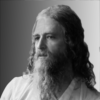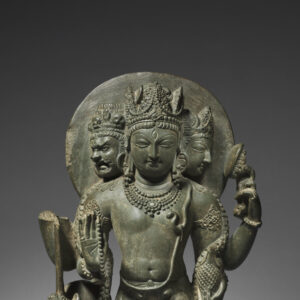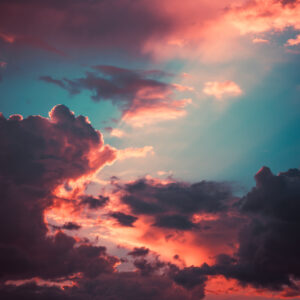When I was a teenager, I held my first job working for my father at his small auto parts store. Being exposed to the world of work and the occupations of different people somehow stirred me deeply. I became very appreciative that things do not appear out of thin air. Bridges, cars, offices, restaurants– these didn’t just magically arise out of nowhere. Human beings had toiled for their construction. This may not sound like a bold realization, but it opened my eyes. I saw that what is created has a creator and that the former is brought into existence through the work of the latter. As a teenager I could only perceive this truth in the human realm; later I came to see that it is true in all realms.
The predominant religious belief of our time regarding creation tells of an omnipotent male God, residing in Heaven, who creates the Earth and all living creatures. The details of the story of the sole creator God vary from land to land, but the basic structure is essentially the same. The presentation dictates an ontological reality in which one Being is the Creator, exclusively responsible for the whole of creation. All other sentient beings are created and have nothing to do with the source of their world. There exists one Cause, who alone begets the universe.
The myth of the sole creator God carries in its wake a problem for the created beings. Since the world was created by someone other than themselves, they end up feeling like strangers in a strange land. In a world of immense complexities and little understood phenomenon, they must tread carefully perchance they violate some rule of order that could result in accident, disease, or death. The drama of creation may be divine, as says the Bible, or it may be a brutal struggle, as postulated by Darwin, but it certainly is as it is, regardless of the wishes of common folk like ourselves. As an audience at a movie theater, we are powerless to change much of what takes place on the screen because the script was written by an ancient, omnipotent Other.
As an alternative to the story that the world was created by one omnipotent Creator acting alone, we may consider the yogic description of lokas or world systems. In this presentation, we find a vastly more complex and challenging perspective of the nature of creation, consciousness, matter, time, and space. Also, we are told that creation is a constant process — eternity is now — and that our experience of life is in our own hands.
A loka, or world system, is a collaborative creation of sentient beings who share its reality. A loka is the creation of the collective consciousness of the beings who inhabit its domain and share in its perceptions. Like a spider who spins a web from her own being, so is a loka spun out of the consciousness of the beings who share a world system. Though a loka has a central creation point, the system itself continually evolves based on the energy exerted by the beings participating in that reality. Just as a city may be built and founded at one date but then changes over time, likewise do lokas continue to evolve.
Each loka is a system unto itself, in the same way, that ecosystems are fully complete. Lokas are also like ecosystems in that they vary greatly, just as the ecosystem of the ocean is vastly different from that of the desert. Some lokas are heavenly; these are the higher astral planes, in which great pleasures can be experienced for extended periods of time. Other lokas are hellish; there the inhabitants experience much pain and suffering. And some lokas, such as the one which includes the planet Earth, provide a vast assortment of possible experiences. Here, some experiences approach the heavenly, some approach the hellish, and most are somewhat in-between — just right for a human being.
Imagine, if you will, a movie theater where the thoughts of each member of the audience can become projected onto the screen. In such a theater, each participant from the audience would project onto the screen what he would like to see. Some would be interested in comedy, others in adventure or romance, and some, as we know from the popularity of the genre, in violence and horror. In true democratic style, each member of the audience would have equal power over the creation of the movie. And, true to democracy, the majority would rule. If 90 people wanted to see a romance and 10 wanted to see a tragedy, the movie would take the form of a romance touched with pathos.
With the creation of such a movie, the likely result would be each member of the audience identifying with what he created. Though each member of the audience creates autonomously, cooperation is possible in such examples as one person creating rain and another creating flowers, or two friends finding one another. The conflict would arise when two people both want to be the monarch or win the same battle. We may ask why anyone would want to project any unhealthy personalities or painful experiences but, as mentioned before, horror stories are very popular in our day and age.
Before continuing with the analogy, it is worth noting that advances in computer sciences and virtual reality technologies may soon make possible some sort of externalization of consciousness. A “theater of the minds” may well be a future form of entertainment, or even result in the construction of some type of external, virtual environment. Contemplating this version of the dynamics of creation may help prepare us to serve in the manifestation of our future on this planet.
If the movie theater analogy is reflective of how creation operates, then we are responsible for the creation of our world, and we are free to create the universe we desire. We could even say this is the intended use of free will. At present, we are creating our world under the duress of an old religious myth, that of the sole Creator God. The problem with this particular myth is that it perpetuates our sense of powerlessness over the past and the unpredictability of the future. In addition, the movie about Adam and Eve, and their original sin which condemns all human beings, horribly haunts our collective subconscious.
We have been taught that sin, guilt, fear, and suffering are our lot and that we just might as well make the best of it. The materialist pursues whatever pleasures he may obtain before death ends his race. The religious man waits for his heavenly reward in the next life for the sufferings and humiliations of his terrestrial existence. Neither of these routes is satisfactory for the yogi. In Self-realization, the yogi becomes aware of the power and glory that are his by virtue of his Divine status. He depends on neither man nor god, for his life is an expression of his own holy consciousness. He projects not scenarios of fear or dependency on the cosmic screen of the universe. He allows other sentient beings their free will to create dramas of pain and tragedy, but he takes no part in their production. Instead, he offers an alternative of peace and compassion: a beauty dream of love and healing.
Although it may seem impossible to imagine what a world without sin, guilt, and fear might look like, such a dream lies in the back of every person’s mind, irrevocably planted there by the Divine. Many have become adult (as in adulterated) about the matter, and have concluded that this beauty dream is simply some childish, innocent fantasy that can never be realized. To the yogi, however, it is simply a question of responsibility. To accept responsibility means to accept that the world as we experience it is the result of our own consciousness. Everyone reaps (experiences in the outer world) just what he has sown (sought for in his own consciousness). The fact that the world seems beyond our control is simply reflective of the degree to which processes of the mind take place on a subc

Revenge
My son, Jahnu, was eight years old, in third grade. We were in the car together and he was obviously in deep thought. I knew



